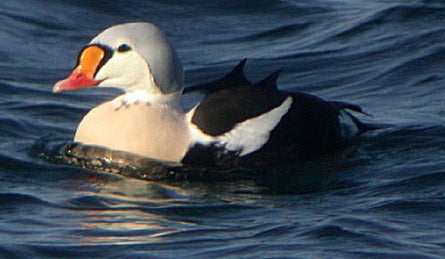SCIENTIFIC NAME:
Somateria spectabilis
STATUS:
Accidental.
DESCRIPTION:
The king eider is a fairly large sea duck. Males range from 22 to 25 inches in length and weigh an average of 3½ pounds. Female king eider are somewhat smaller, averaging 21 inches in length and 3¼ pounds. Males have distinctive head coloration like no other species. Their head is characterized by a short orange bill that sweeps upward to form an orange knoblike fronted shield – this shield is outlined in black and is associated with a pale blue crest - hence the name. At a distance males appear white on the front of the body and black on the rear. Females are dusky brown in color and are heavily barred with black.
DISTRIBUTION:
King eider occur throughout the arctic regions of coastal Canada, Alaska, Russia, Siberia, Greenland and Scandinavia. Breeding grounds for this species are along Arctic Islands of the Northwest Territories, the Arctic coast and along the western coastline of Hudson Bay. King eiders winter in areas as far north as open water permits. In areas such as the Bering Sea, king eiders can be seen intermixed with other sea ducks during the winter months. This species has been known to frequent the Great Lakes, however this does not occur on a regular basis.
HABITAT:
Somateria spectabilis spend the vast majority of their life at sea and are only dependent on land during the nesting period.
FEEDING HABITS:
King eiders feed primarily on mollusks, crustaceans and echinoderms that inhabit the ocean floor. These birds commonly dive to a depth of 65 feet in order to obtain these food items.
LIFE HISTORY AND ECOLOGY:
King eiders differ from other species in that they do not nest in colonies or on ocean islands, instead pairs move inland to breed. They usually nest on the shores of lakes and rivers. Occasionally, nests are located on the tundra a considerable distance from water. Females are believed to breed when they are 3 years old. Nests are composed of down from the female and plant material. An average clutch varies from to 3 to 6 eggs. Incubation is about 23 days. Once the eggs are laid, males leave and go back to the open ocean in large groups. The females are responsible for incubation and care of the young During this period females will not eat and will only leave the nest to get fresh water. Primary nest predators are arctic fox and glaucous birds.
King eiders are long distance travelers that migrate in flocks sometimes numbering more than 10,000. They are highly social animals and large flocks will congregate in most northern bays and inlets.
The estimated population level of this species seems to be on the decrease. Causes of this population decline are unknown.
REFERENCES:
Bellrose. F.C. 1976. Ducks, geese & Swans of North America, 2nd. Ed. Stackpole, PA.
https://seaduckjv.org. Sea duck joint venture.
Peterson, R.T. 1947. A field guide to the Birds. pp. 35.
AUTHOR:
Michael E. Sievering, Alabama Division of Wildlife and Freshwater Fisheries






